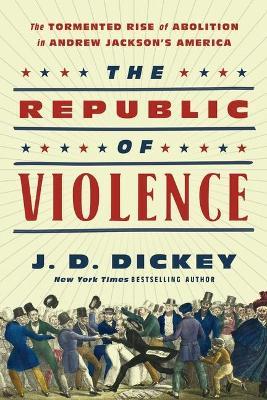The Republic of Violence: The Tormented Rise of Abolition in Andrew Jackson's America

The Republic of Violence: The Tormented Rise of Abolition in Andrew Jackson's America
A New York Times bestselling author reveals the story of a nearly forgotten moment in American history, when mass violence was not an aberration, but a regular activity--and nearly extinguished the Abolition movement. The 1830s were the most violent time in American history outside of war. Men battled each other in the streets in ethnic and religious conflicts, gangs of party henchmen rioted at the ballot box, and assault and murder were common enough as to seem unremarkable. The president who presided over the era, Andrew Jackson, was himself a duelist and carried lead in his body from previous gunfights. It all made for such a volatile atmosphere that a young Abraham Lincoln said "outrages committed by mobs form the every-day news of the times." The principal targets of mob violence were abolitionists and black citizens, who had begun to question the foundation of the U.S. economy -- chattel slavery -- and demand an end to it. Led by figures like William Lloyd Garrison and James Forten, the anti-slavery movement grew from a small band of committed activists to a growing social force that attracted new followers in the hundreds, and enemies in the thousands. Even in the North, abolitionists faced almost unimaginable hatred, with newspaper publishers, businessmen with a stake in the slave trade, and politicians of all stripes demanding they be suppressed, silenced or even executed. Carrying bricks and torches, guns and knives, mobs created pandemonium, and forced the abolition movement to answer key questions as it began to grow: Could nonviolence work in the face of arson and attempted murder? Could its leaders stick together long enough to build a movement with staying power, or would they turn on each other first? And could it survive to last through the decade, and inspire a new generation of activists to fight for the cause? J.D. Dickey reveals the stories of these Black and white men and women persevered against such threats to demand that all citizens be given the chance for freedom and liberty embodied in the Declaration of Independence. Their sacrifices and strategies would set a precedent for the social movements to follow, and lead the nation toward war and emancipation, in the most turbulent era of our republic of violence.
PRP: 158.40 Lei
Acesta este Prețul Recomandat de Producător. Prețul de vânzare al produsului este afișat mai jos.
126.72Lei
126.72Lei
158.40 LeiLivrare in 2-4 saptamani
Descrierea produsului
A New York Times bestselling author reveals the story of a nearly forgotten moment in American history, when mass violence was not an aberration, but a regular activity--and nearly extinguished the Abolition movement. The 1830s were the most violent time in American history outside of war. Men battled each other in the streets in ethnic and religious conflicts, gangs of party henchmen rioted at the ballot box, and assault and murder were common enough as to seem unremarkable. The president who presided over the era, Andrew Jackson, was himself a duelist and carried lead in his body from previous gunfights. It all made for such a volatile atmosphere that a young Abraham Lincoln said "outrages committed by mobs form the every-day news of the times." The principal targets of mob violence were abolitionists and black citizens, who had begun to question the foundation of the U.S. economy -- chattel slavery -- and demand an end to it. Led by figures like William Lloyd Garrison and James Forten, the anti-slavery movement grew from a small band of committed activists to a growing social force that attracted new followers in the hundreds, and enemies in the thousands. Even in the North, abolitionists faced almost unimaginable hatred, with newspaper publishers, businessmen with a stake in the slave trade, and politicians of all stripes demanding they be suppressed, silenced or even executed. Carrying bricks and torches, guns and knives, mobs created pandemonium, and forced the abolition movement to answer key questions as it began to grow: Could nonviolence work in the face of arson and attempted murder? Could its leaders stick together long enough to build a movement with staying power, or would they turn on each other first? And could it survive to last through the decade, and inspire a new generation of activists to fight for the cause? J.D. Dickey reveals the stories of these Black and white men and women persevered against such threats to demand that all citizens be given the chance for freedom and liberty embodied in the Declaration of Independence. Their sacrifices and strategies would set a precedent for the social movements to follow, and lead the nation toward war and emancipation, in the most turbulent era of our republic of violence.
Detaliile produsului









